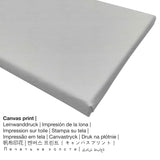John Opie, 18th century - Street Singer and Child - fine art print
Taxes incluses. Frais de port calculés au paiement.
Specifications of the article
John Opie painted the 18th century artwork Street Singer and Child. The original had the size: Framed: 100 x 87,5 x 11 cm (39 3/8 x 34 7/16 x 4 5/16 in); Unframed: 76,5 x 64,3 cm (30 1/8 x 25 5/16 in). Oil on canvas was applied by the British artist as the technique for the masterpiece. Inscribed across book: "LOVE/CLOWN (N or R). is the masterpiece's inscription. Today, the work of art is part of the digital art collection of The Cleveland Museum of Art, which is one of the leading museums worldwide that builds, preserves, studies, and shares its outstanding collections of art from all periods and parts of the world, generating new scholarship and understanding, while serving as a social and intellectual hub for its community. With courtesy of: The Cleveland Museum of Art (license: public domain). Creditline of the artwork: Gift of Mr. and Mrs. J. H. Wade. Further, the alignment of the digital reproduction is in portrait format and has a ratio of 1 : 1.2, meaning that the length is 20% shorter than the width. The painter John Opie was an artist, whose art style can primarily be classified as Rococo. The Rococo painter lived for a total of 46 years and was born in the year 1761 in Saint Agnes, Cornwall, England, United Kingdom and died in the year 1807.
Select the item material you will hang up in your home
For every fine art print we offer a range of different sizes and materials. We allow you to pick your favorite size and material among the following product individualization options:
- Poster (canvas material): The Artprinta poster is a UV printed flat canvas with a fine surface texture. Please keep in mind, that depending on the size of the poster we add a white margin 2-6cm round about the work of art, which facilitates the framing with your custom frame.
- Aluminium dibond print (metal): This is a metal print manufactured on alu dibond material with an impressive effect of depth. For the Direct Aluminium Dibond option, we print the selected artpiece onto the surface of the aluminum material.
- Printed acrylic glass: A glossy print on acrylic glass, often denoted as a UV print on plexiglass, makes an original work of art into décor.
- Canvas: A UV printed canvas mounted on a wooden frame. A canvas makes the plastic look of three-dimensionality. What is more, canvas generates a cosy and pleasant atmosphere. Your canvas of this artpiece will allow you to transform your into a large collection piece. The great advantage of canvas prints is that they are relatively low in weight, meaning that it is easy and straightforward to hang up your Canvas print without the help of extra wall-mounts. Because of thatcanvas prints are suitable for any type of wall.
Legal disclaimer: We try what we can to depict our products as accurately as possible and to showcase them visually. Please keep in mind that the tone of the print materials and the imprint can diverge somehwat from the representation on your device's screen. Depending on the screen settings and the condition of the surface, not all colors are printed as exactly as the digital version. Considering that the are printed and processed by hand, there might as well be slight deviations in the motif's size and exact position.
About this article
| Product type: | wall art |
| Reproduction: | digital reproduction |
| Manufacturing method: | UV print / digital printing |
| Manufacturing: | German production |
| Stock type: | on demand |
| Intended usage: | art print gallery, wall art |
| Orientation of the image: | portrait alignment |
| Image aspect ratio: | 1 : 1.2 |
| Implication: | the length is 20% shorter than the width |
| Fabric variants: | acrylic glass print (with real glass coating), poster print (canvas paper), metal print (aluminium dibond), canvas print |
| Canvas print (canvas on stretcher frame): | 50x60cm - 20x24", 100x120cm - 39x47", 150x180cm - 59x71" |
| Acrylic glass print (with real glass coating) variants: | 50x60cm - 20x24", 100x120cm - 39x47" |
| Poster print (canvas paper): | 50x60cm - 20x24", 100x120cm - 39x47" |
| Aluminium print sizes: | 50x60cm - 20x24", 100x120cm - 39x47" |
| Framing of the art copy: | unframed reproduction |
Piece of art details
| Name of the work of art: | "Street Singer and Child" |
| Artwork categorization: | painting |
| Umbrella term: | contemporary art |
| Period: | 18th century |
| Medium of original artwork: | oil on canvas |
| Original dimensions: | Framed: 100 x 87,5 x 11 cm (39 3/8 x 34 7/16 x 4 5/16 in); Unframed: 76,5 x 64,3 cm (30 1/8 x 25 5/16 in) |
| Original artwork signature: | inscribed across book: "LOVE/CLOWN (N or R). |
| Exhibited in: | The Cleveland Museum of Art |
| Place of the museum: | Cleveland, Ohio, United States of America |
| Website of the museum: | www.clevelandart.org |
| Artwork license: | public domain |
| Courtesy of: | The Cleveland Museum of Art |
| Artwork creditline: | Gift of Mr. and Mrs. J. H. Wade |
Artist information
| Name: | John Opie |
| Alternative names: | John Opie, Opie John, Opie, J. Opie R. A., J. Opie R.A., John Opie R. A., opie j., Opie R.A., J. Opie, Opie R. A., John Opie Esq., Mr. Opie, J. Opie Esq., opie john, jone opie |
| Artist gender: | male |
| Nationality: | British |
| Professions of the artist: | painter |
| Country of origin: | the United Kingdom |
| Classification: | old master |
| Art styles: | Rococo |
| Died at the age of: | 46 years |
| Birth year: | 1761 |
| Hometown: | Saint Agnes, Cornwall, England, United Kingdom |
| Year died: | 1807 |
| Town of death: | London, Greater London, England, United Kingdom |
This text is copyrighted © - Artprinta (www.artprinta.com)
General specifications from the museum's website (© Copyright - The Cleveland Museum of Art - The Cleveland Museum of Art)
The son of a Cornish coal miner, John Opie sympathized with the British working classes. This painting demonstrates his interest in an honest portrayal of British street life, a sympathy rarely seen in the work of other British artists of his generation, who often presented lower classes more coldly. Much of Britain's population at this time was poor, but beggars and street vendors had a particularly low status. Street singers were often sellers of goods. By focusing the composition tightly on the woman and not including any wares, Opie makes the viewer recognize her humanity; moreover, he emphasizes the connection between mother and child. The singer is working to feed her baby, evoking sympathy from the viewer.














